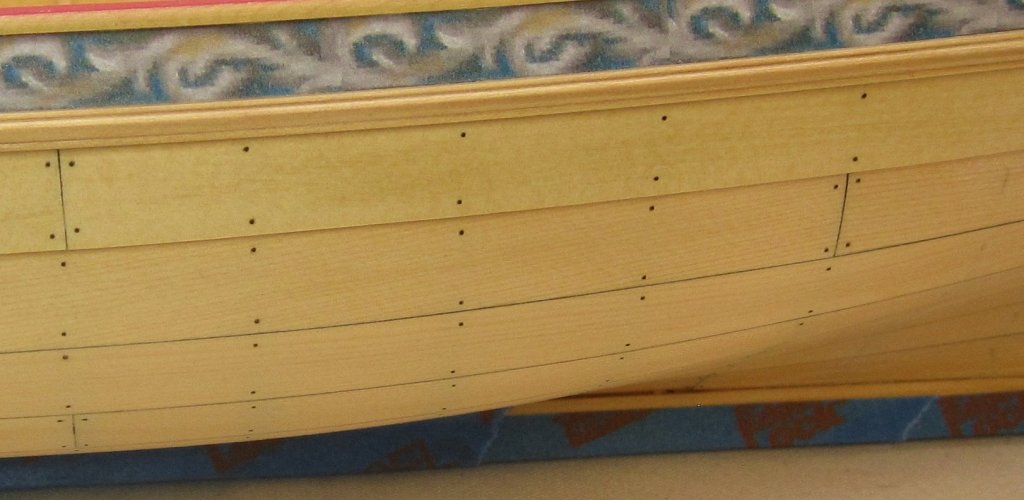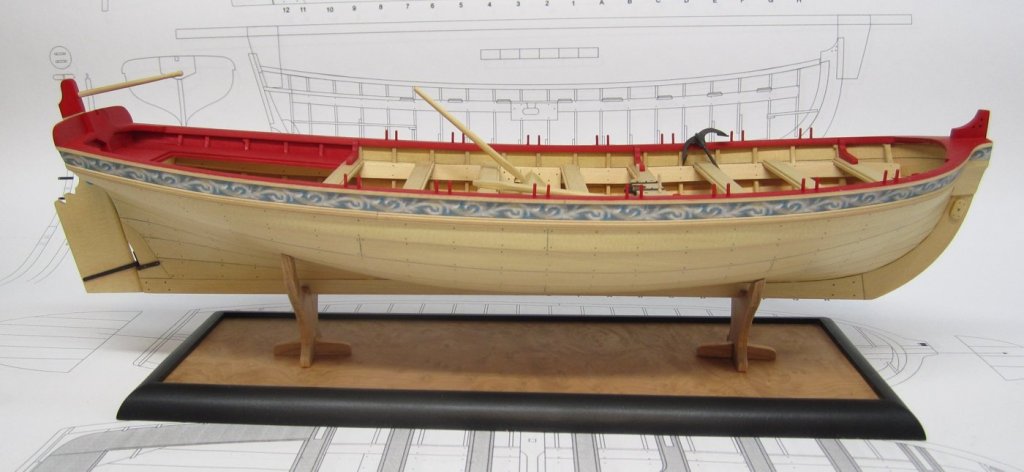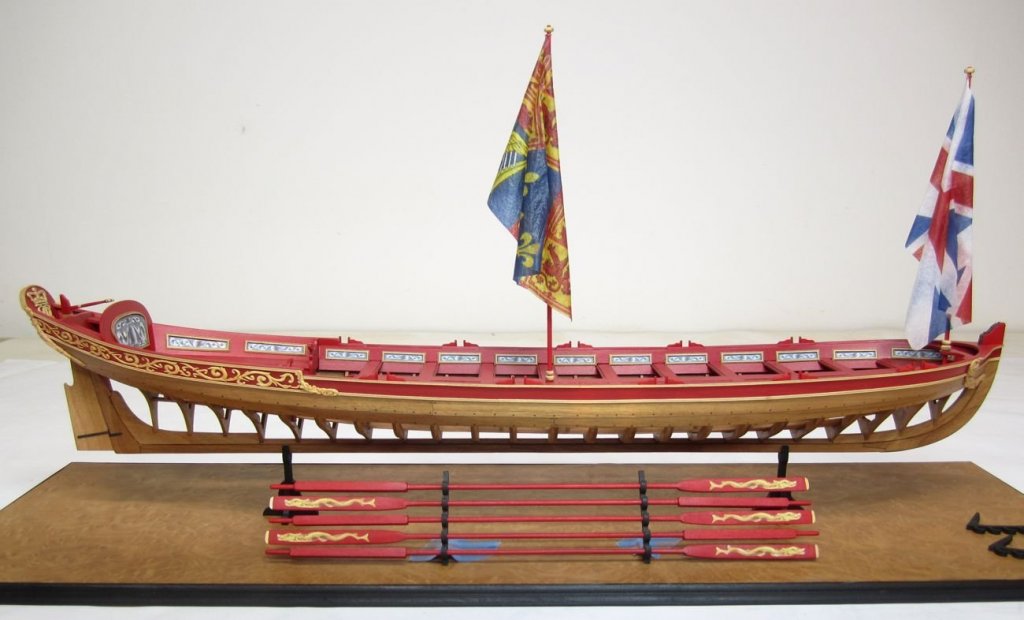-
Posts
9,665 -
Joined
-
Last visited
Content Type
Profiles
Forums
Gallery
Events
Everything posted by Chuck
-
That is a very good start. Looks like a lot of fun to build.
- 312 replies
-
- enterprise
- caf
-
(and 1 more)
Tagged with:
-
I would go with the boxwood or pear. all that stiff is painted either red or black. Like the contemporary model. Picture this with the addition of gun carriages painted red also.
- 642 replies
-
- winchelsea
- Syren Ship Model Company
-
(and 1 more)
Tagged with:
-
Is that pear on the right? Looks dark for boxwood. The cedar would compliment the carvings and friezes better and tie in with them. The holly may be too light. But using Pear would keep it all consistent. I personally like the decks the same color as the hull planking but thats just me. You need to thing about how the deck fittings would look against the deck planks if you use pear and and paint most of the fittings down the deck. Its a tough decision. One I anguish over all the time.
- 642 replies
-
- winchelsea
- Syren Ship Model Company
-
(and 1 more)
Tagged with:
-
Just use a straight razor blade to slice it flush. Works the best. I use CA to glue them in the holes. But seriously you dont have to use any glue at all. If your hole is the correct diameter and you get a good tight fit. Then when you apply the wipe on poly and it dries it will act like additional glue. You can simply sand the hull to after you use the straight razor to make the line flush. Use a fine grit say 320. Its a very simple process. Your treenails may have started out as #78 bits but my guess is they were made much larger by whatever awl you used or the pencil. They look way too large. Thats the issue. With cedar the wood is soft and prone to enlarged holes. Also....Not that big a deal if you dont add treenails at all. Its a real nice look. Much preferred over a poor job of treenailing. Run more tests before you even touch the model.
- 778 replies
-
- cheerful
- Syren Ship Model Company
-
(and 1 more)
Tagged with:
-
You did a great job on that planking. It would be a real shame to ruin that with an odd treenailing job. I wouldnt just put them at the butt joints. That looks awful. It only looks right if the treenails are to scale and placed where they would be. The sample board you made is definitely too large. That would really be a mistake in my opinion. I would not go larger than a #78 drill bit. You might want to try using brown mono-filament. You can even use black....I would go with 10 pound stock and nothing larger than 12 lb fishing line. They would be nice and neat. A brown line looks very good and I have seen one Cheerful hull done that way and it looks great. Otherwise the treenails can get too large with irregular shape. The other very good option is to not show treenails at all. That planking looks so good it would be a shame to ruin it with an odd pattern or large treenails. It would look fantastic as it is right now.
- 778 replies
-
- cheerful
- Syren Ship Model Company
-
(and 1 more)
Tagged with:
-
No not at this time. Maybe a lot later down the road. It would be too huge for me to rig. But plans for rigging her may be done way way down the road. Chuck
- 1,784 replies
-
- winchelsea
- Syren Ship Model Company
-
(and 1 more)
Tagged with:
-
Blocks would have been 8" long and at that scale they would be??? 3/32" long I believe. I know its challenging but I would also consider making the ring bolt smaller in the carriage. That would help. It looks to be about 8" round considering the block size in the photo. Maybe try with thinner gauge wire. Chuck
-

Ripping Planks - what I've learned from others
Chuck replied to glbarlow's topic in Modeling tools and Workshop Equipment
Yupp, thats how I do it. I dont use a push stick or any blocks. I just use my hands. Maybe some would see this as unsafe but i feel I get more control actually with my hands touching the sheet being milled. For me its the safer way to go. With thinner sheets....like 1/32” sheets where I am ripping 1/32” x 1/32” strips, I will use two or three clamps on the fence to keep the wood down on the table. The thin sheets want to bend and buckle and more clamps seem to do the trick as a hold down. Its really not hard to do and just takes a bit of practice getting comfortable. -
Yes that looks very good indeed. Well done.
- 144 replies
-
- winchelsea
- Syren Ship Model Company
-
(and 1 more)
Tagged with:
-
They look OK....the length wont affect things. But yes they are the typical funky shape for commercial ones being very bulbous on the tops. I am more worried about you not being able to get the rope coils over the top of those because they are so close together. But it will probably be OK. I think you should use the longer ones. They are much better than the shorter ones.
- 160 replies
-
- cheerful
- Syren Ship Model Company
-
(and 1 more)
Tagged with:
-

ancre Coureur by cafmodel - 1/48
Chuck replied to cafmodel's topic in - Build logs for subjects built 1751 - 1800
Wonderful news Tom......😃 -
Chapter four materials list has been uploaded in the first post of this topic. I am working on finishing up the Chapter 4 of the monograph now and should have the parts ready as well. Maybe a few days more. Take a look at the materials list though because when you buy the package for the laser cut parts for chapter four.....you may need to get more 2" planking sheets to rip planks/strips for your gun deck and bulwarks. It depends on how many you have left.....I added how many I used four chapter 4 to the list....as well as two 4" wide sheets of 3/64" cedar so you guys can make your margin planks. Rather than laser cut these it is better if you make them to fit your model perfectly. I uploaded the template for them as they will absolutely need to be tweaked to fit your model well. I uploaded it to the Winnie plans download forum.....where you downloaded the plans. Chuck
-

Beware ordering Trident Alert...no refunds and order cancelled!!!
Chuck replied to wormwood's topic in Wood ship model kits
Thats bad.....Trident has been accused of violating free trade? That sounds very very serious indeed. Accused by who? It all does sound a bit shady. I wouldnt touch this with a ten foot pole. Maybe cut your losses and buy the CAF Coureur instead. Get your refund but I wouldnt send them any more money. I am 100% certain that you would be better off with CAF as they actually have their own website. I am not sure how you would even contact Trident without them having a website. Trident Model is a member here on MSW and I will ask them to respond. I must unfortunately also mention that my last two private messages to Trident some weeks ago went unanswered so we shall see. Keep us posted. -
Those flags look really good. Very realistic and to scale. You shaped them pretty darn good too. If you alternate the blades of the sweeps on the left and right sides of each stack, it looks much better and more balanced.
- 221 replies
-
- queen anne barge
- Syren Ship Model Company
-
(and 1 more)
Tagged with:
-

Beware ordering Trident Alert...no refunds and order cancelled!!!
Chuck replied to wormwood's topic in Wood ship model kits
Wormwood, welcome to MSW. You should introduce yourself to the forum in the area we have set up for it here. https://modelshipworld.com/forum/3-new-member-introductions/ As this is your first post, it is customary to do so. However I appreciate you giving us details of your transactions with Trident. It certainly doesnt sound good at all. I have read on SOS that there are many folks who have had their orders cancelled without warning and they have not gotten their money back. This is for the new Alert kit. I would recommend that everyone be very cautious and certainly wait before placing an order. You dont want to get in the middle of a bad situation. I dont quite understand the situation but as far as I have been told and what I have read on SOS, its not a very good situation. I hope it worksd out for you and you get your money back. As it is China....I am not sure what if any protections you might have. Maybe through your CC company. Thanks for letting us know and keep us updated. I edited the title of this topic so folks more readily know what it is about. Chuck -

HMS Winchelsea (1764) 32 gun frigate GROUP PROJECT INFO
Chuck replied to Chuck's topic in Group Projects on Model Ship World
You could try it. I have not heard of that. But there is no way to tell until you try it. It could work well.
About us
Modelshipworld - Advancing Ship Modeling through Research
SSL Secured
Your security is important for us so this Website is SSL-Secured
NRG Mailing Address
Nautical Research Guild
237 South Lincoln Street
Westmont IL, 60559-1917
Model Ship World ® and the MSW logo are Registered Trademarks, and belong to the Nautical Research Guild (United States Patent and Trademark Office: No. 6,929,264 & No. 6,929,274, registered Dec. 20, 2022)
Helpful Links
About the NRG
If you enjoy building ship models that are historically accurate as well as beautiful, then The Nautical Research Guild (NRG) is just right for you.
The Guild is a non-profit educational organization whose mission is to “Advance Ship Modeling Through Research”. We provide support to our members in their efforts to raise the quality of their model ships.
The Nautical Research Guild has published our world-renowned quarterly magazine, The Nautical Research Journal, since 1955. The pages of the Journal are full of articles by accomplished ship modelers who show you how they create those exquisite details on their models, and by maritime historians who show you the correct details to build. The Journal is available in both print and digital editions. Go to the NRG web site (www.thenrg.org) to download a complimentary digital copy of the Journal. The NRG also publishes plan sets, books and compilations of back issues of the Journal and the former Ships in Scale and Model Ship Builder magazines.







